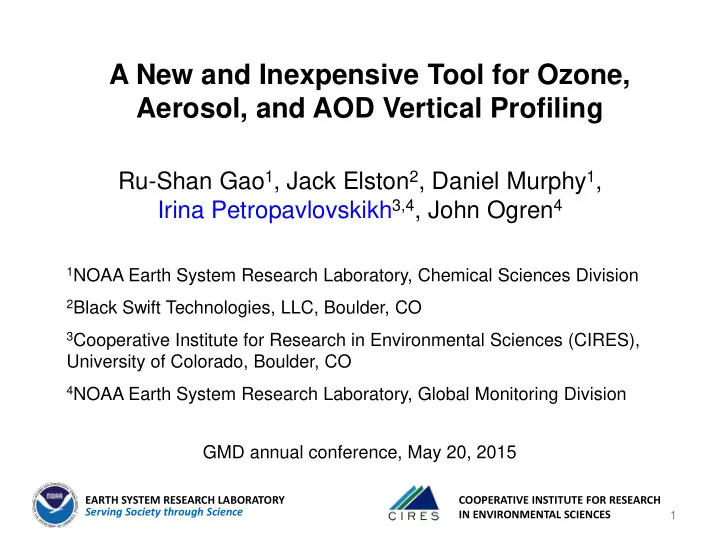

A New and Inexpensive Tool for Ozone, Aerosol, and AOD Vertical Profiling Ru-Shan Gao 1 , Jack Elston 2 , Daniel Murphy 1 , Irina Petropavlovskikh 3,4 , John Ogren 4 1 NOAA Earth System Research Laboratory, Chemical Sciences Division 2 Black Swift Technologies, LLC, Boulder, CO 3 Cooperative Institute for Research in Environmental Sciences (CIRES), University of Colorado, Boulder, CO 4 NOAA Earth System Research Laboratory, Global Monitoring Division GMD annual conference, May 20, 2015 EARTH SYSTEM RESEARCH LABORATORY COOPERATIVE INSTITUTE FOR RESEARCH Serving Society through Science IN ENVIRONMENTAL SCIENCES 1
Major uncertainties: • Transport • Vertical distribution • Aerosol hygroscopicity • Aerosol light absorption NASA SeaWIFS
How to address these uncertainties: • Ideally , global profiles (5 km) of O 3 , RH, aerosol, aerosol hygroscopicity and absorption properties, AOD, and AAOD are measured at high frequency (weekly, at least) with reasonable vertical resolution. • Realistically , it is too difficult to do it right. Satellite: Little vertical info, no info on aerosol property Aircraft: Too expensive UASs: Too expensive, FAA limitation Non-recoverable balloon instruments: Too expensive • New proposed approach for measurement tool Key criteria: Low equipment cost, low operation cost, and reliable measurements of known uncertainty.
Our new tool: • Weather balloon based, < 6 lbs. - FAA regulation on small gliders might be less restrictive: Ease of operation Balloon • Light and inexpensive instruments ($Ks per instrument, “lose-able”) - Low equipment cost • Autonomously homing gliders or parafoils - Low operation cost ($350 per launch) - 5-km ceiling for easy recovery Instrumented auto-homing glider, SKYWALKER
Instrumented auto-homing glider Total weight = 5.6 lbs. Optical particle counter ECC ozone sensor Scanning photometer 2.1 m Flight control by Black Swift Technologies Ground station Autopilot Tablet UI
Movie of the glider test
New instruments developed at NOAA/CSD Printed Optical Particle Spectrometer (POPS) - Single-particle detection - 150 - 2500nm diameter range - 800 g, 7 Watts - Lose-able (~$2500) Gao et al. Mini Scanning Aerosol Solar Photometer (Mini-SASP) - 4 wavelength (460, 550, 670, 860 nm) - 0.02 AOD detection limit - 350 g, 2 Watts - Lose-able (~$1500) Murphy et al. 7
New instruments under development at NOAA/CSD/GMD Prototype Mini-Continuous Light Absorption Photometer - Particle absorption detection - 3 wavelengths (467, 528, 652 nm) - Precision < 0.2 Mm -1 (estimated) - 1000 g, 10 Watts (estimated) - Lose-able Gao, Ting, et al. Other possible instruments: • Condensation Nuclei Counter (CNC) • Filter-based Aerosol Chemical Sampler • Whole Air Sampler (WAS) • NO 2 , CO 2 , CH 4, CO sensors
Two instrument packages so far: Package 1: Vertically resolved O 3 + Aerosols • Deliverables: O 3 profile Dry aerosol AOD (derived) profiles RH effect: AOD/(Dry aerosol AOD) Aerosol-weighed RH • All instruments are robust and uncertainties can be quantified Package 2: Aerosol optical and physical composition. • Deliverables: Aerosol particle distribution Aerosol Abs. Coef. profiles Aerosol AOD (derived) Dry AAOD (derived) • CLAP is a proven instrument
Application: The Global Ozone and Aerosol profiles and Aerosol Hygroscopic Effect and Absorption optical Depth (GOA 2 HEAD) Network Initiative Ru-Shan Gao 1 , Jim Elkins 2 , Greg Frost 1 , Si-Wan Kim 1 , Allison McComiskey 2 , Daniel Murphy 1 , John Ogren 2 , Irina Petropavlovskikh 2 , Karen Rosenlof 1 1 Chemical Sciences Division 2 Global Monitoring Division Earth System Research Laboratory Boulder, Colorado
Thank you for flying with GOA 2 HEAD
Instruments (commercially available): Ozone (O 3 ) Pressure Temperature Relative humidity (RH) DMT ECC ozonesonde; 250 g, ~$850
New instruments developed at NOAA/CSD Open-pass aerosol extinction sensor - 450 or 670 nm - Estimated 1 Mm -1 sensitivity - Closable to zero signal Gordon and Murphy 13
Two instrument packages so far: Package 1: O 3 , RH, dry aerosol, AOD • Instruments: ECC O 3 (250 g), p, T, RH,( ~100 g), POPS w/ dryer attachment (dry aerosol number density and size distribution, 800 g), mini-SASP (AOD, 350 g) • Deliverables: - O 3 , dry aerosol, and AOD profiles - Aerosol-weighed RH - Dry aerosol AOD (derived) - AOD - RH effect: AOD/(Dry aerosol AOD) • All instruments are robust and uncertainties can be quantified
Package 2: Ambient aerosol and aerosol absorption coef. • Instruments: ABS (dry aerosol absorption coefficient; miniaturized GMD CLAP instrument, or “mini-CLAP”), POPS (aerosol number density and size distribution), radiosonde (p, T, RH) • Deliverables: - Aerosol and AAC profiles - Aerosol AOD (derived) - Dry AAOD (derived) • CLAP is a proven instrument
Recommend
More recommend